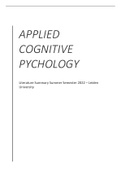Summary
Applied Cognitive Psychology - Literature Summary (Leiden University, 2022)
- Course
- Institution
All mandatory articles/chapters of the specialisation Applied Cognitive Psychology, Leiden University Summer Semester 2022, are summarised in this document. - Passed the exam with an 8.5
[Show more]



